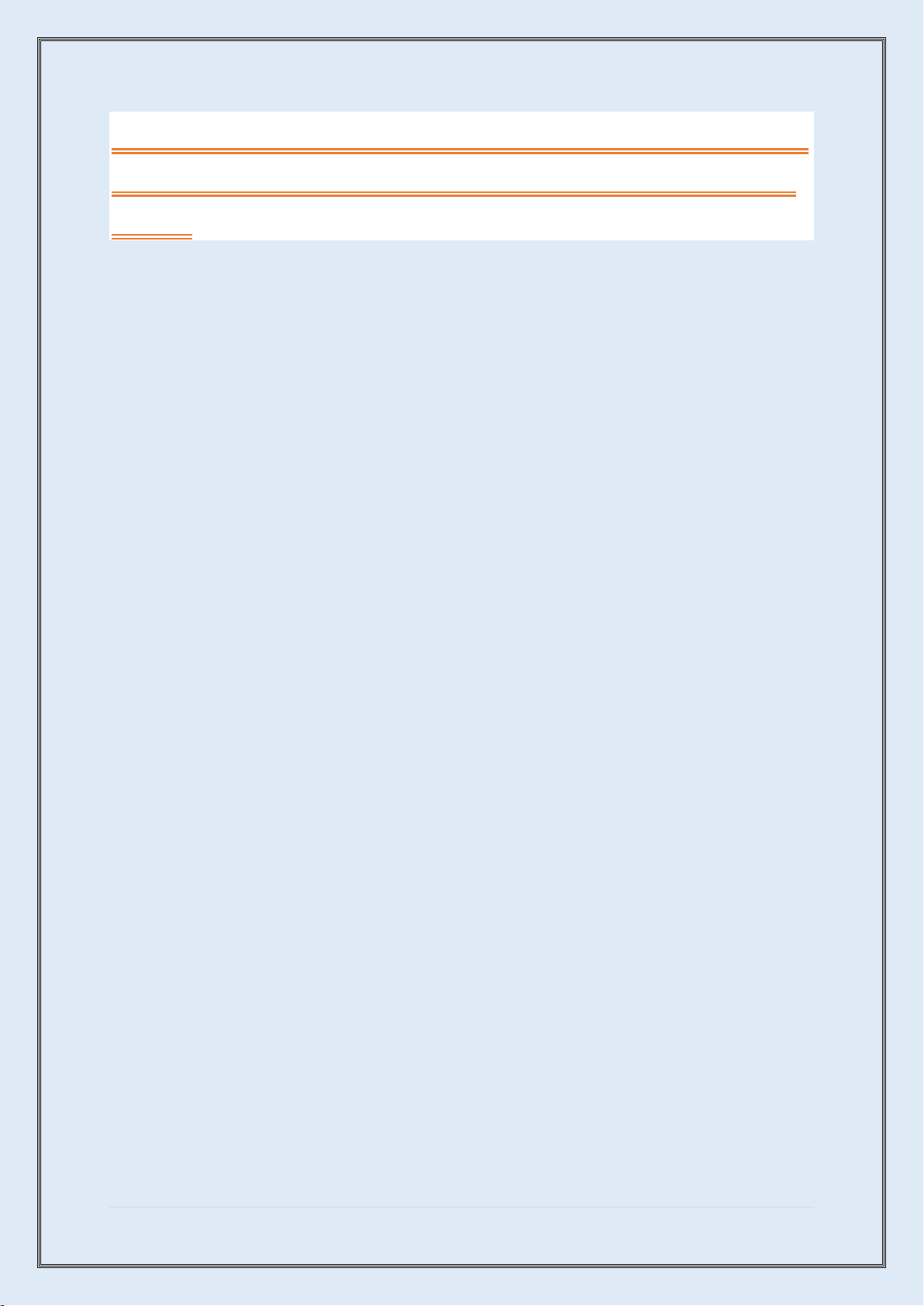
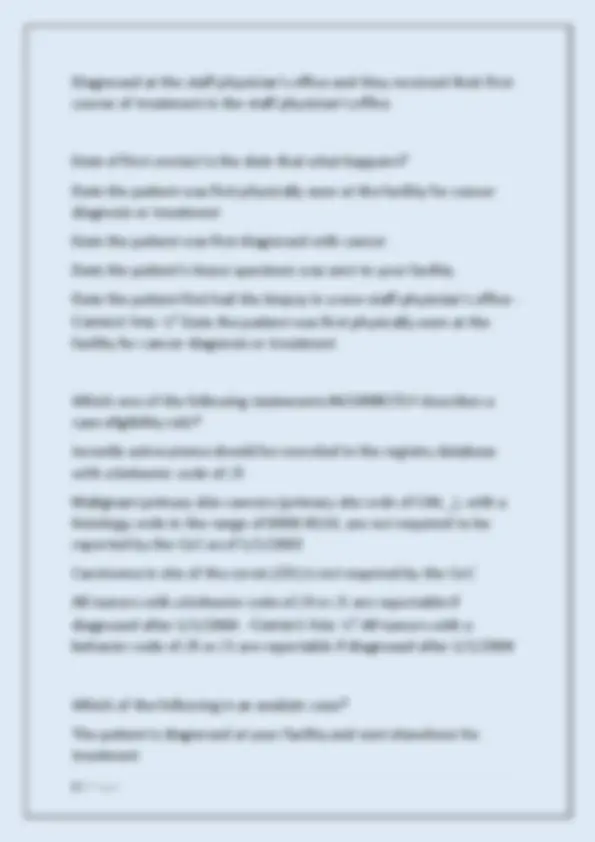
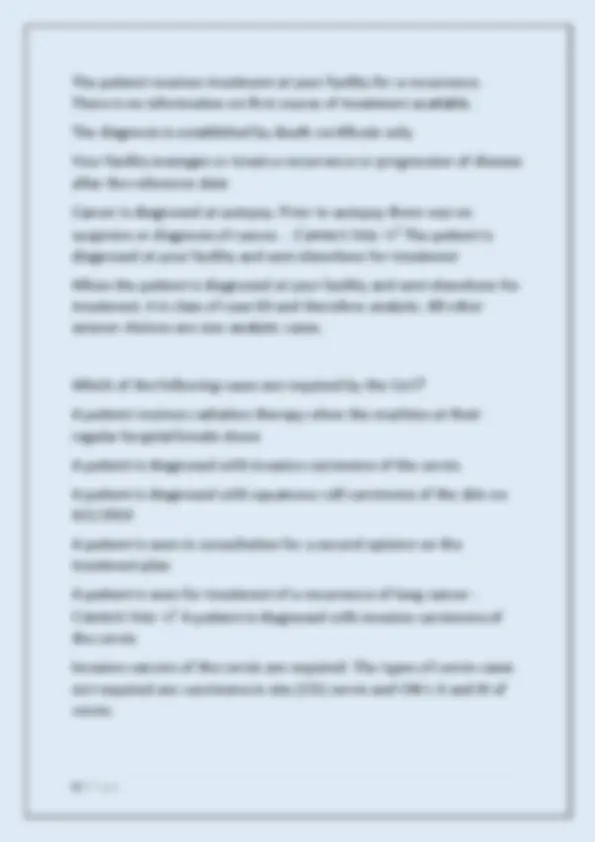
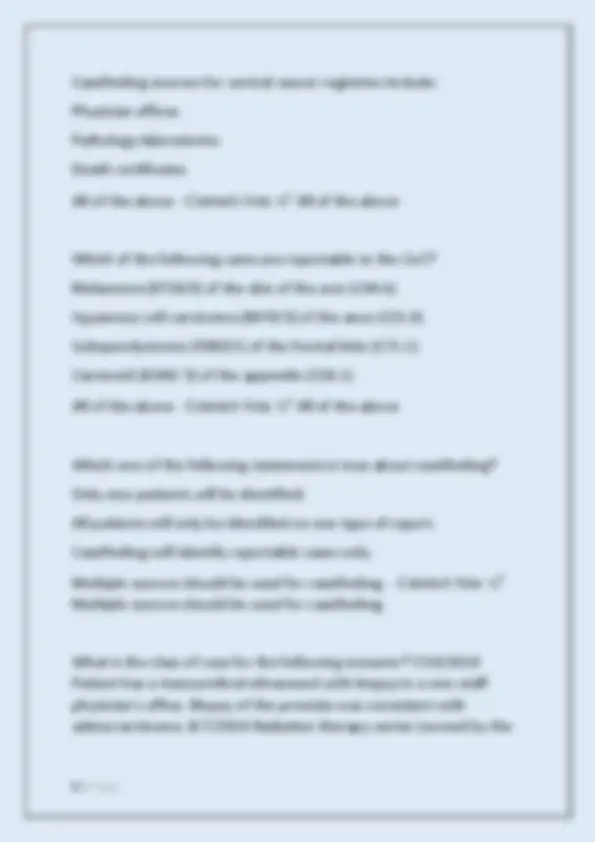
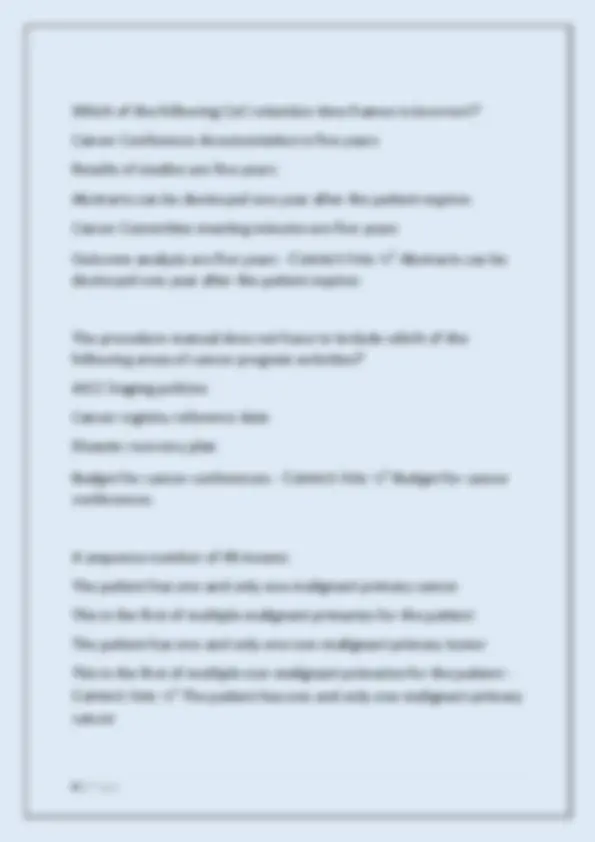
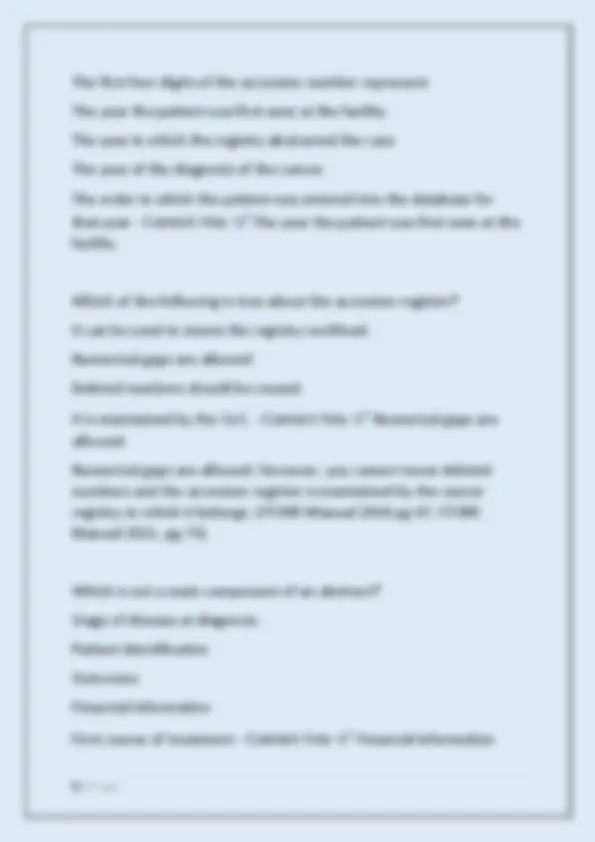
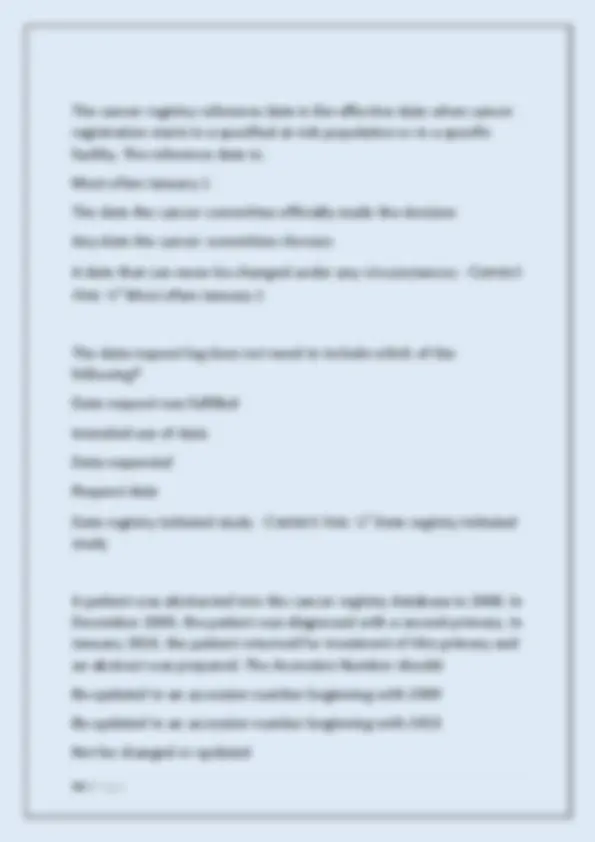
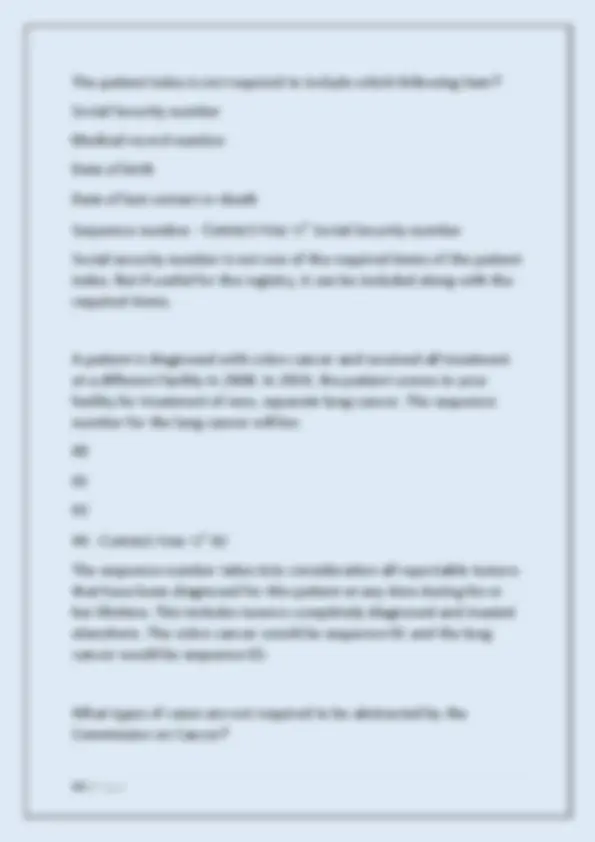
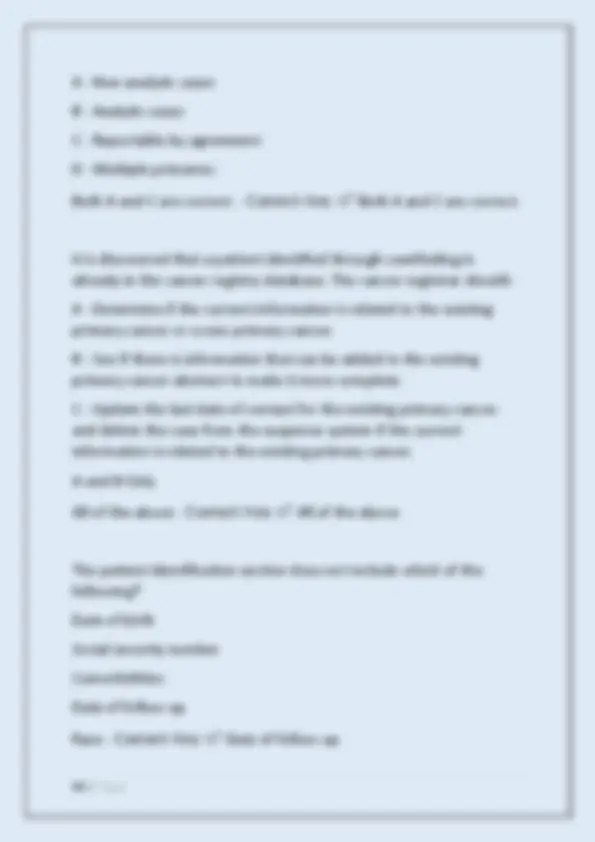
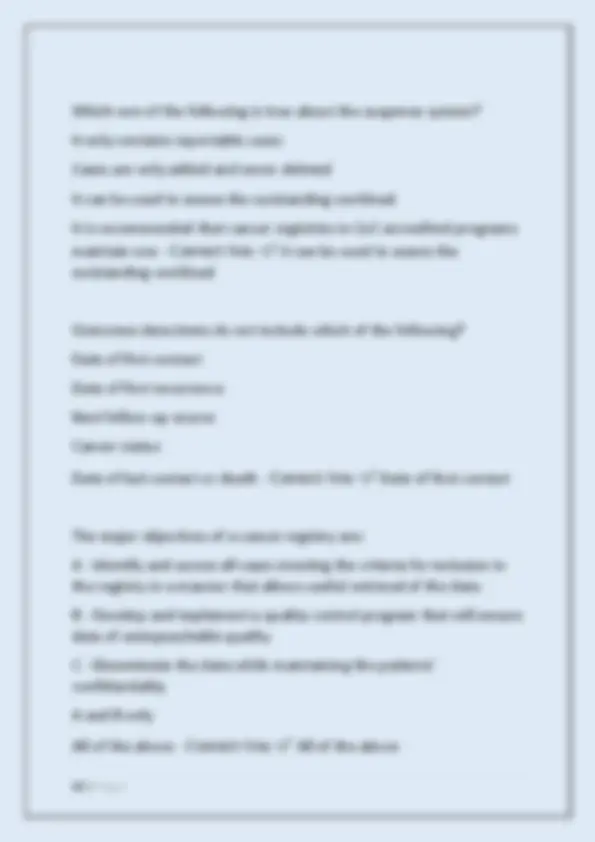
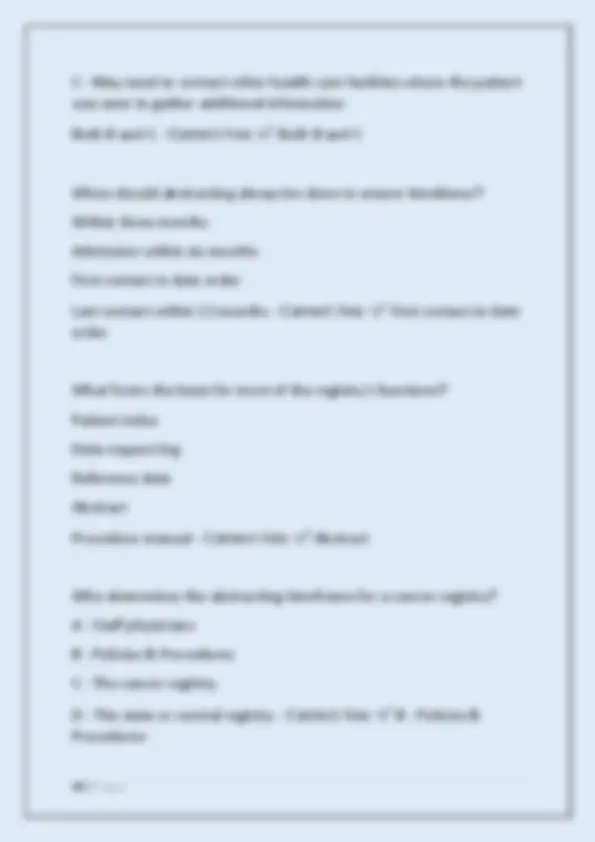
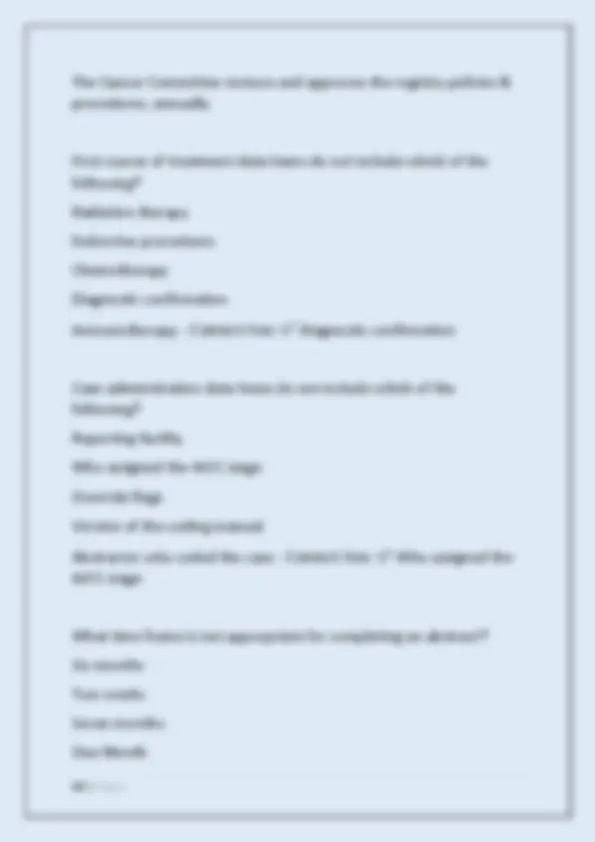
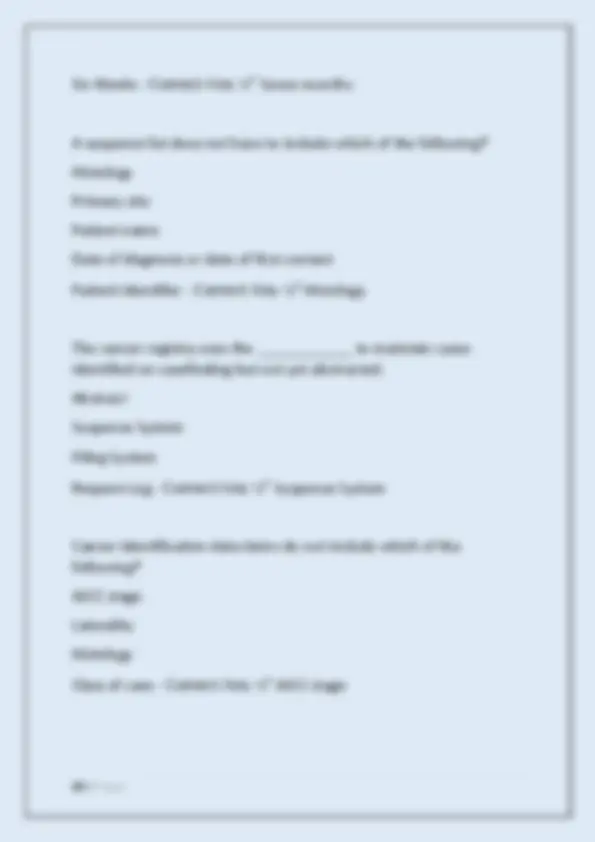
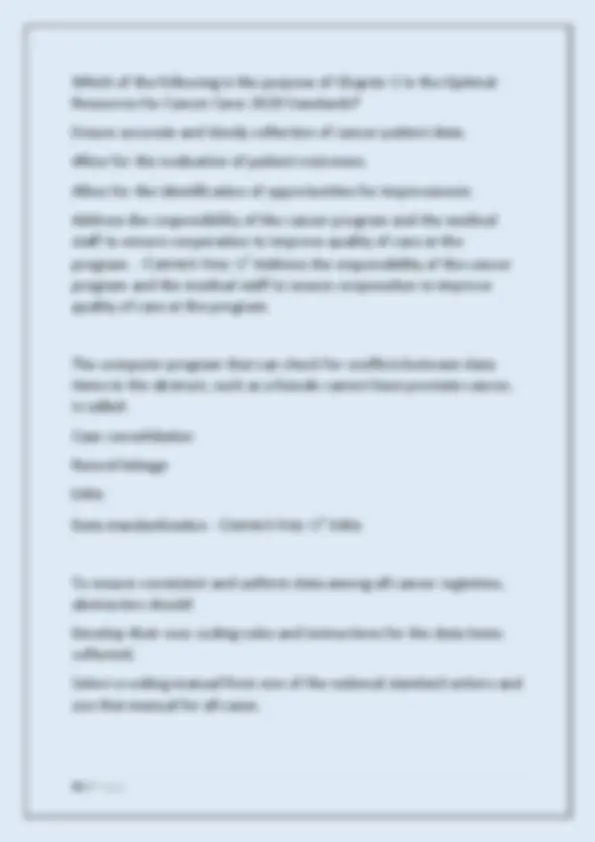
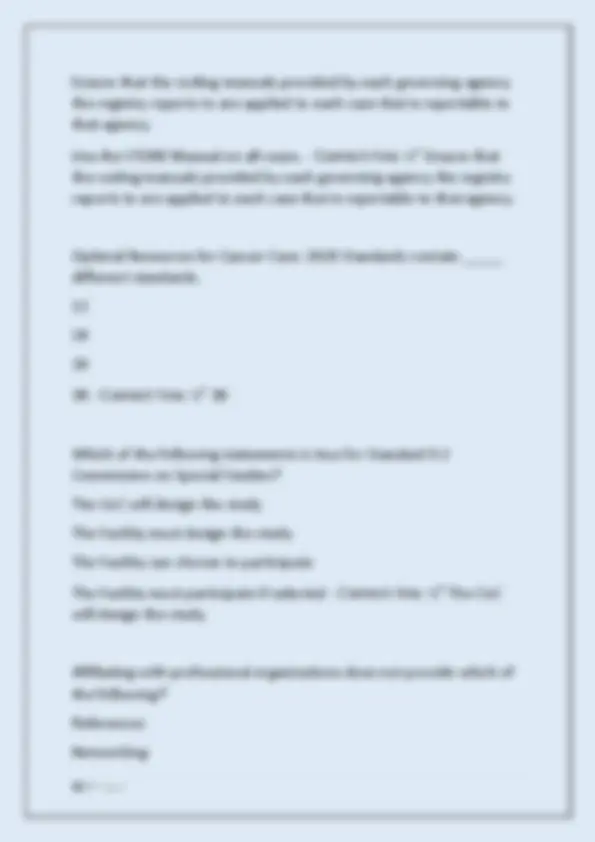
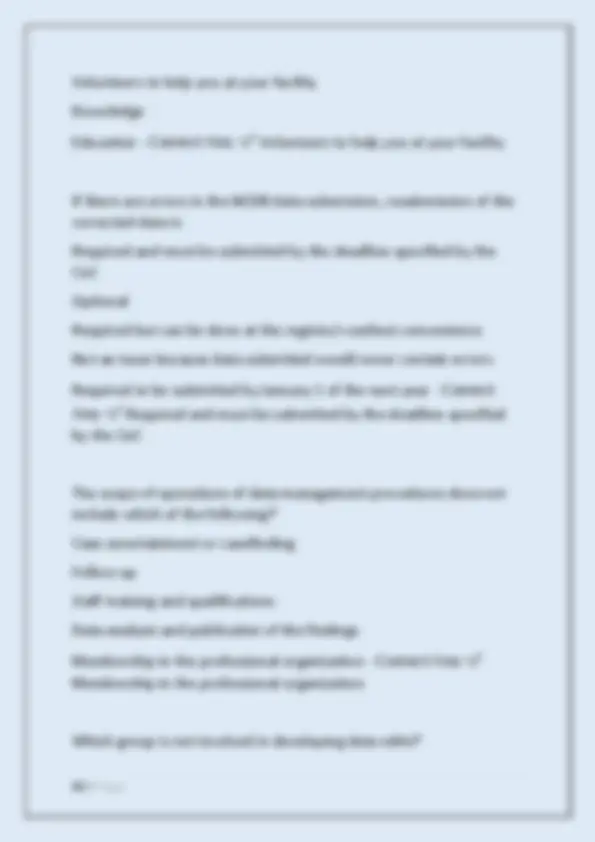
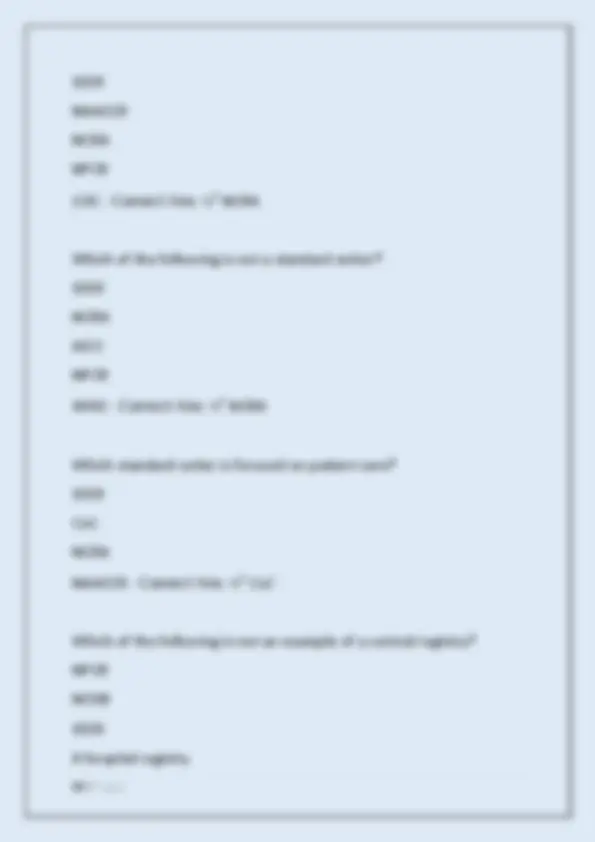
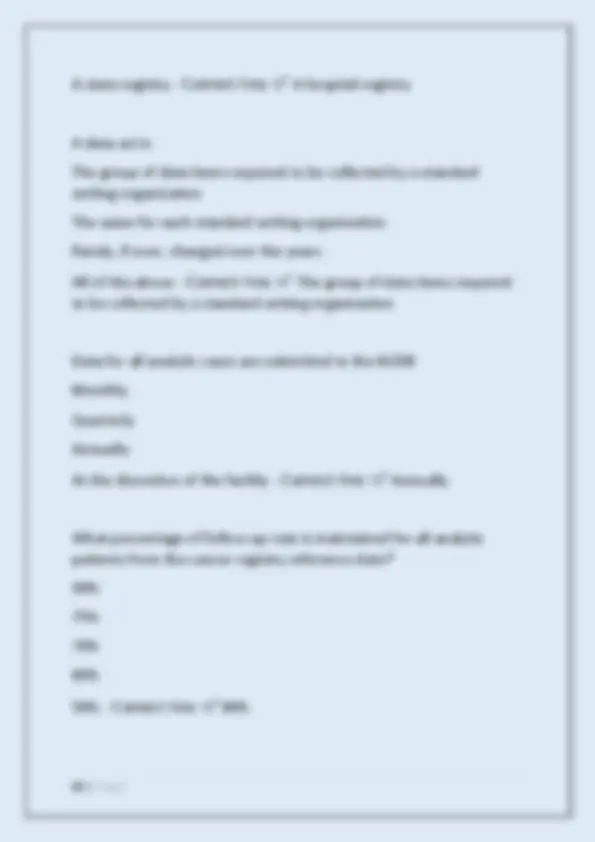
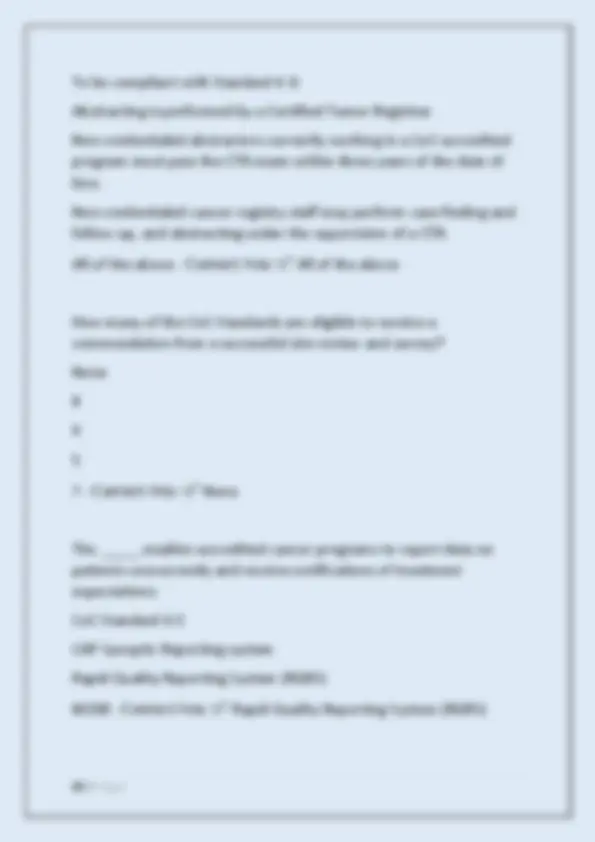
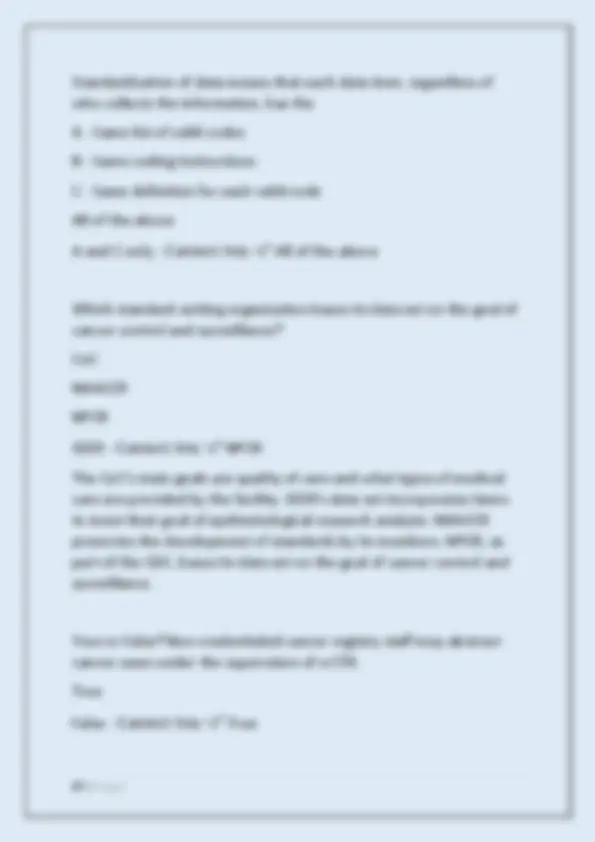
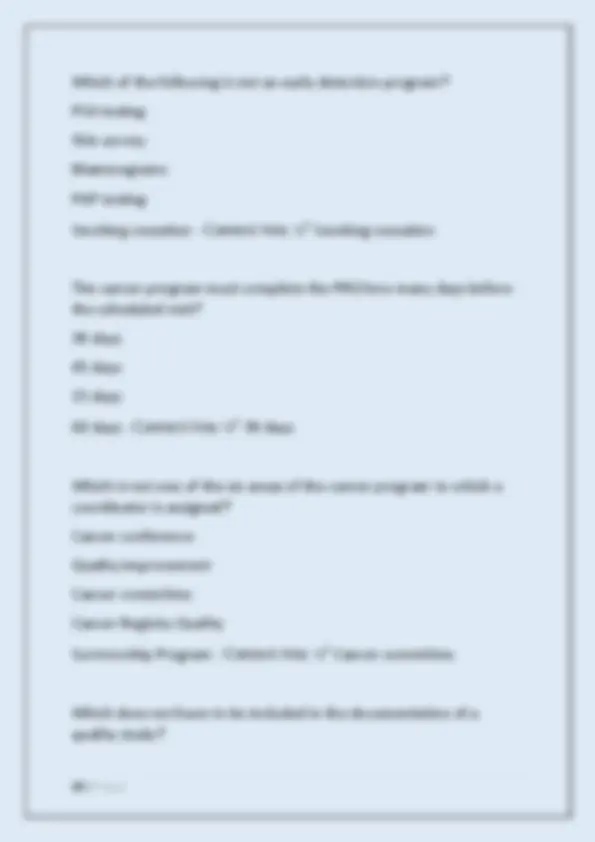
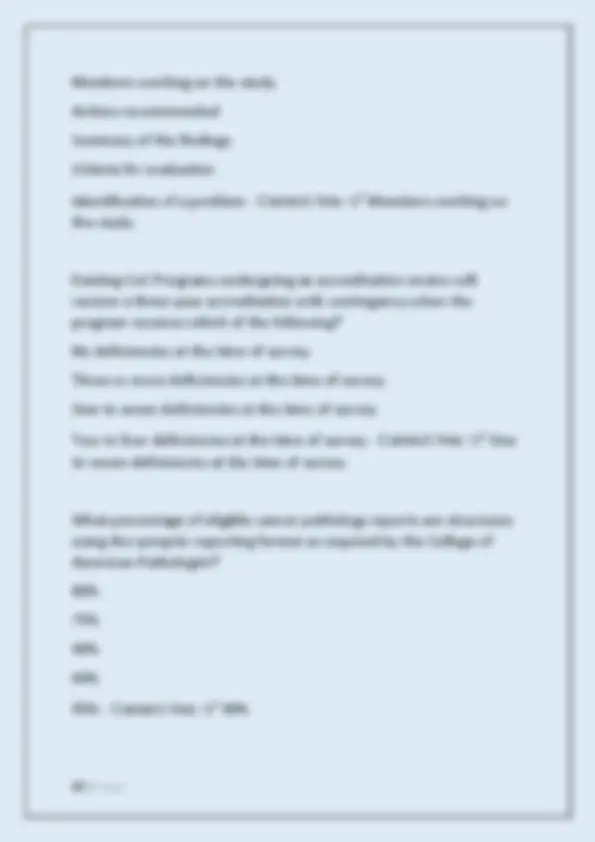
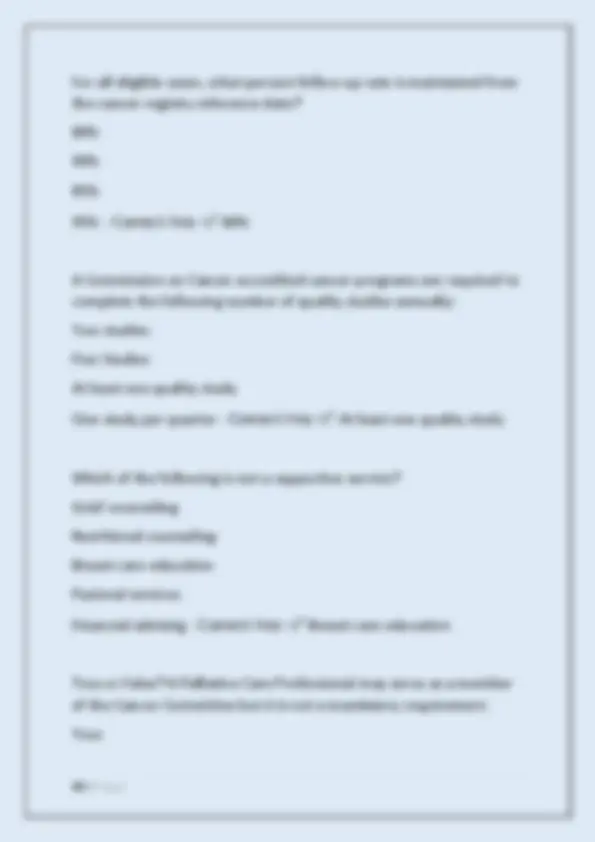
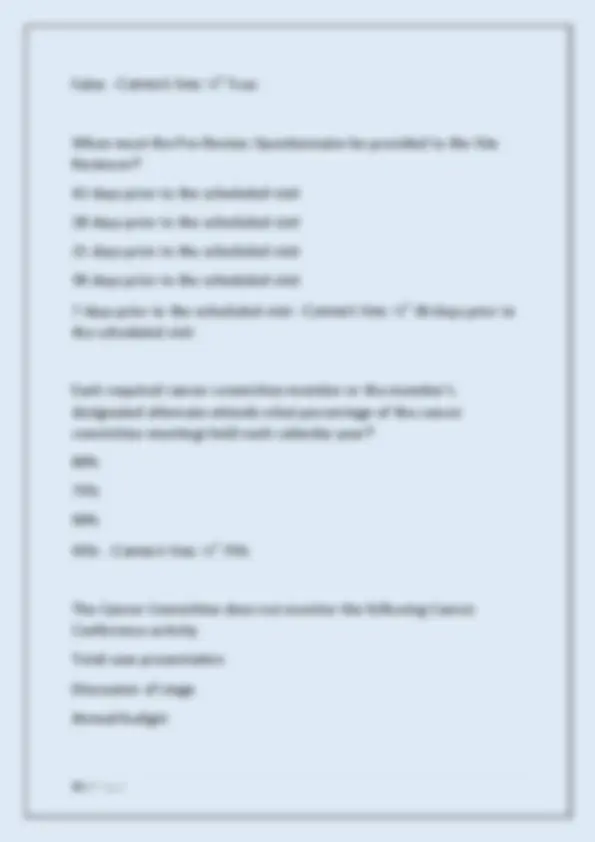
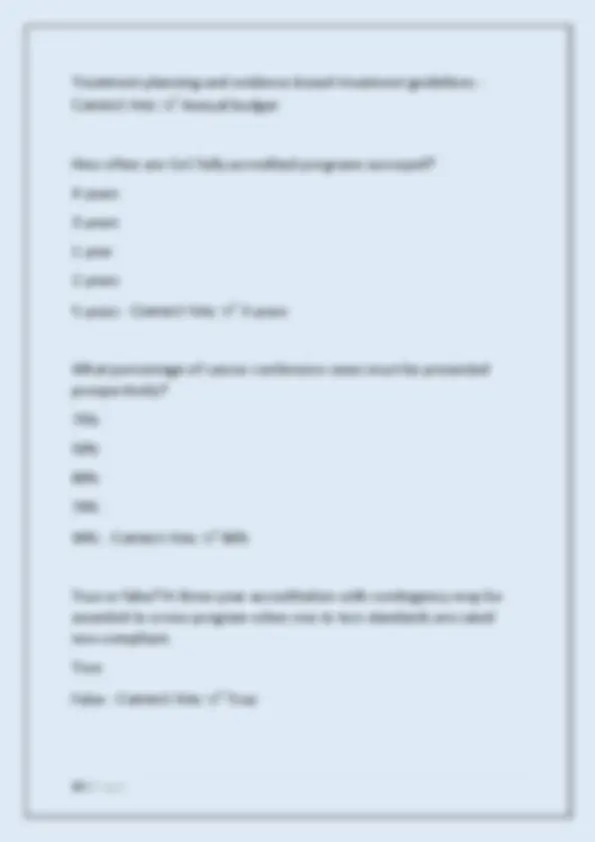
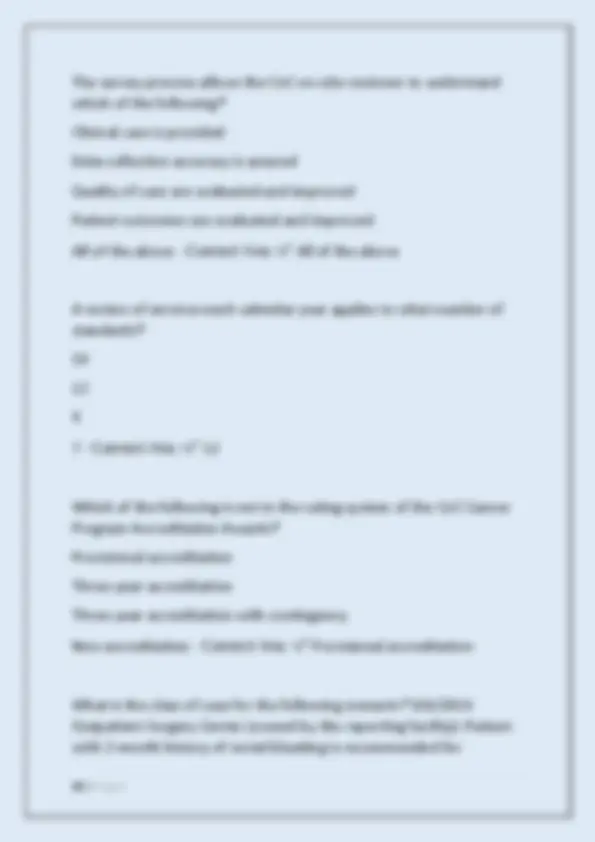
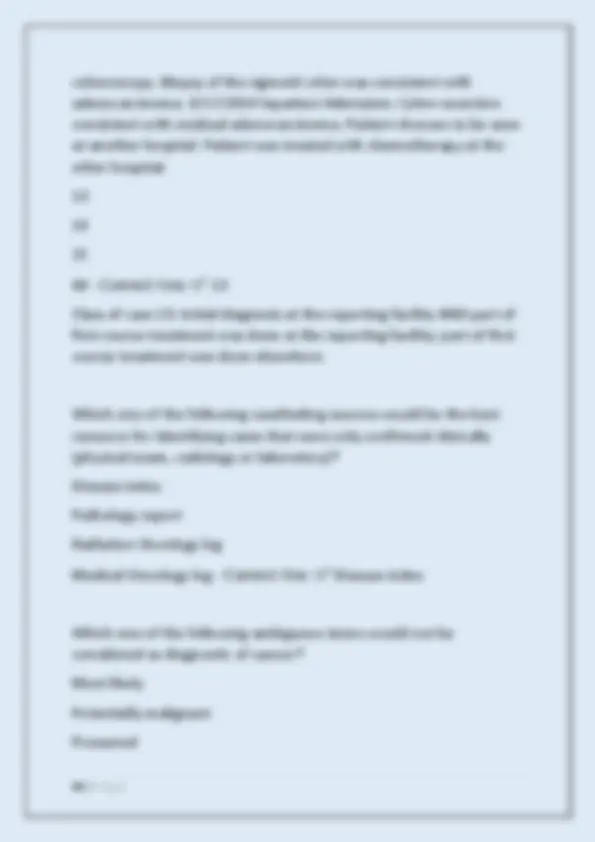
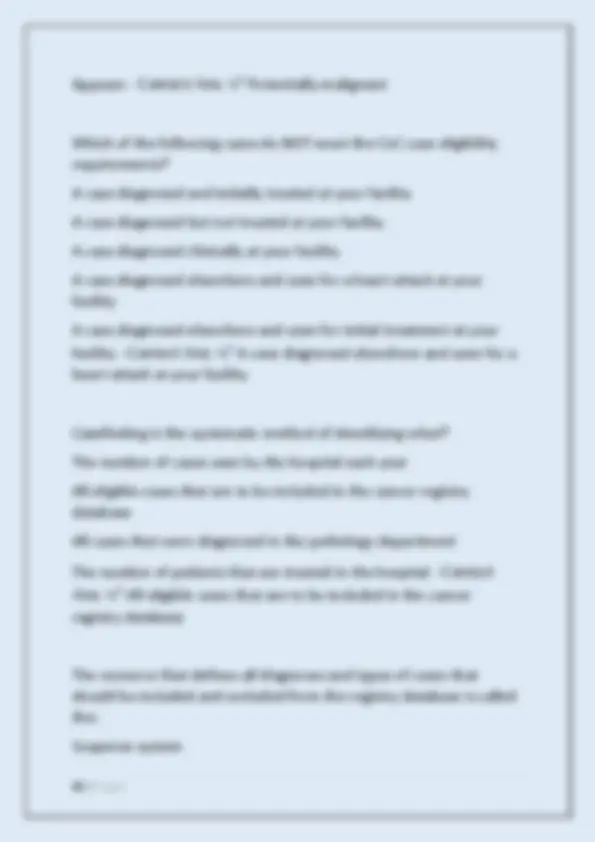



Study with the several resources on Docsity

Earn points by helping other students or get them with a premium plan


Prepare for your exams
Study with the several resources on Docsity

Earn points to download
Earn points by helping other students or get them with a premium plan
Community
Ask the community for help and clear up your study doubts
Discover the best universities in your country according to Docsity users
Free resources
Download our free guides on studying techniques, anxiety management strategies, and thesis advice from Docsity tutors
A series of multiple choice questions and answers related to cancer registry operations. It covers topics such as case eligibility criteria, casefinding sources, class of case codes, and accession number conventions. Designed to help users understand the key concepts and procedures involved in cancer registry operations.
Typology: Exams
1 / 36

This page cannot be seen from the preview
Don't miss anything!





























Which of the following is a non-analytic case?
The patient is diagnosed at the facility and it is unknown whether or not treatment was recommended or administered.
The patient is diagnosed at the facility and is referred elsewhere for treatment.
The patient was diagnosed and treated for a malignancy elsewhere, and presents to your facility for treatment for recurrence or progression of disease.
The patient is diagnosed elsewhere, and all or part of the first course
of treatment is performed at the facility. - Correct Ans: ✅ The patient was diagnosed and treated for a malignancy elsewhere, and presents to your facility for treatment for recurrence or progression of disease.
A patient who has been diagnosed and received all first course treatment elsewhere for a malignancy, but is then treated at your facility for recurrence or progression of the same disease is class of case 32.
Which of the following class of case code ranges are NOT required by the CoC to be reported?
A - 00
B - 10-
C - 20-
Both D and E - Correct Ans: ✅ Both D and E
Which of the following is NOT true about the analytic class of case codes?
They are routinely used for statistics in the registry
They are cases diagnosed and/or treated at your facility
They are required to be accessioned, abstracted and followed by the CoC
They are cases first seen after your facility's reference date
They are cases first suspected or diagnosed with cancer at autopsy -
Correct Ans: ✅ They are cases first suspected or diagnosed with cancer at autopsy
Which of the following scenarios would NOT be in the class of case 10-14 range?
Diagnosed at the facility and patient refuses treatment
Diagnosed at the staff physician's office and they received their first course of treatment in the staff physician's office
Diagnosed at the facility and their treatment plan is for watchful waiting
Diagnosed at the facility and treatment was recommended, but it is unknown whether it was administered
Diagnosed at the facility and were given palliative care only due to
age, advanced disease, or other medical conditions - Correct Ans: ✅
The patient receives treatment at your facility for a recurrence. There is no information on first course of treatment available.
The diagnosis is established by death certificate only
Your facility manages or treats a recurrence or progression of disease after the reference date
Cancer is diagnosed at autopsy. Prior to autopsy there was no
suspicion or diagnosis of cancer. - Correct Ans: ✅ The patient is diagnosed at your facility and sent elsewhere for treatment
When the patient is diagnosed at your facility and sent elsewhere for treatment, it is class of case 00 and therefore analytic. All other answer choices are non-analytic cases.
Which of the following cases are required by the CoC?
A patient receives radiation therapy when the machine at their regular hospital breaks down
A patient is diagnosed with invasive carcinoma of the cervix.
A patient is diagnosed with squamous cell carcinoma of the skin on 4/1/
A patient is seen in consultation for a second opinion on the treatment plan
A patient is seen for treatment of a recurrence of lung cancer -
Correct Ans: ✅ A patient is diagnosed with invasive carcinoma of the cervix.
Invasive cancers of the cervix are required. The types of cervix cases not required are carcinoma in situ (CIS) cervix and CIN I, II and III of cervix.
Casefinding sources for central cancer registries include:
Physician offices
Pathology laboratories
Death certificates
All of the above - Correct Ans: ✅ All of the above
Which of the following cases are reportable to the CoC?
Melanoma (8720/3) of the skin of the arm (C44.6)
Squamous cell carcinoma (8070/3) of the anus (C21.0)
Subependymoma (9383/1) of the frontal lobe (C71.1)
Carcinoid (8240/ 3) of the appendix (C18.1)
All of the above - Correct Ans: ✅ All of the above
Which one of the following statements is true about casefinding?
Only new patients will be identified.
All patients will only be identified on one type of report.
Casefinding will identify reportable cases only.
Multiple sources should be used for casefinding. - Correct Ans: ✅ Multiple sources should be used for casefinding.
What is the class of case for the following scenario? 7/19/ Patient has a transurethral ultrasound with biopsy in a non-staff physician's office. Biopsy of the prostate was consistent with adenocarcinoma. 8/7/2010 Radiation therapy center (owned by the
D - The pathology specimen of lung tissue is consistent with a neoplasm.
Both B and D - Correct Ans: ✅ Both B and D
If cytology is identified only with ambiguous term, do not interpret it as cancer; abstract only if followed by biopsy which confirms diagnosis. "Neoplasm" constitutes a diagnosis for CNS tumors only, effective with 2004 cases.
Who must approve the registry procedure manual according to the CoC?
Immediate supervisor
Facility CEO
Cancer Committee
Cancer Liaison Physician
Department Director - Correct Ans: ✅ Cancer Committee
The five (or more) digits which follow the year in the accession number represent:
The sequential order in which the patient was entered into the database for that year
The year the patient was first seen at the facility
The sequence of all reportable tumors over the lifetime of a patient
The sequential order in which the patient was entered into the
database since the reference date - Correct Ans: ✅ The sequential order in which the patient was entered into the database for that year
Which of the following CoC retention time frames is incorrect?
Cancer Conference documentation is five years
Results of studies are five years
Abstracts can be destroyed one year after the patient expires
Cancer Committee meeting minutes are five years
Outcome analysis are five years - Correct Ans: ✅ Abstracts can be destroyed one year after the patient expires
The procedure manual does not have to include which of the following areas of cancer program activities?
AJCC Staging policies
Cancer registry reference date
Disaster recovery plan
Budget for cancer conferences - Correct Ans: ✅ Budget for cancer conferences
A sequence number of 00 means:
The patient has one and only one malignant primary cancer
This is the first of multiple malignant primaries for the patient
The patient has one and only one non-malignant primary tumor
This is the first of multiple non-malignant primaries for the patient -
Correct Ans: ✅ The patient has one and only one malignant primary cancer
The cancer registry reference date is the effective date when cancer registration starts in a specified at-risk population or in a specific facility. The reference date is:
Most often January 1
The date the cancer committee officially made the decision
Any date the cancer committee chooses
A date that can never be changed under any circumstances - Correct
Ans: ✅ Most often January 1
The data request log does not need to include which of the following?
Date request was fulfilled
Intended use of data
Data requested
Request date
Date registry initiated study - Correct Ans: ✅ Date registry initiated study
A patient was abstracted into the cancer registry database in 2008. In December 2009, the patient was diagnosed with a second primary. In January 2010, the patient returned for treatment of this primary and an abstract was prepared. The Accession Number should:
Be updated to an accession number beginning with 2009
Be updated to an accession number beginning with 2010
Not be changed or updated
0 - Correct Ans: ✅ Not be changed or updated
An abstract is created:
A - For all primaries that your registry is required to report
B - For each independent primary for the same patient
C - Once for each patient, regardless of the number of primaries they have
Both A and B
Both A and C - Correct Ans: ✅ Both A and B
True or False? If two cancers or two tumors are diagnosed at the same time, assign the lower sequence number to the one with the worst prognosis.
True
False - Correct Ans: ✅ True
A patient is diagnosed with a benign tumor of the brain at your facility. This is the only reportable tumor for this patient. The sequence number for this tumor will be:
00
01
60
61 - Correct Ans: ✅ 60
The range for non-malignant primary cancers is from 60-88. This includes benign (behavior code /0) and borderline (behavior code /1)
The patient index is not required to include which following item?
Social Security number
Medical record number
Date of birth
Date of last contact or death
Sequence number - Correct Ans: ✅ Social Security number
Social security number is not one of the required items of the patient index. But if useful for the registry, it can be included along with the required items.
A patient is diagnosed with colon cancer and received all treatment at a different facility in 2008. In 2010, the patient comes to your facility for treatment of new, separate lung cancer. The sequence number for the lung cancer will be:
00
01
02
99 - Correct Ans: ✅ 02
The sequence number takes into consideration all reportable tumors that have been diagnosed for this patient at any time during his or her lifetime. This includes tumors completely diagnosed and treated elsewhere. The colon cancer would be sequence 01 and the lung cancer would be sequence 02.
What types of cases are not required to be abstracted by the Commission on Cancer?
A - Non-analytic cases
B - Analytic cases
C - Reportable-by agreement
D - Multiple primaries
Both A and C are correct. - Correct Ans: ✅ Both A and C are correct.
It is discovered that a patient identified through casefinding is already in the cancer registry database. The cancer registrar should:
A - Determine if the current information is related to the existing primary cancer or a new primary cancer.
B - See if there is information that can be added to the existing primary cancer abstract to make it more complete.
C - Update the last date of contact for the existing primary cancer and delete the case from the suspense system if the current information is related to the existing primary cancer.
A and B Only
All of the above - Correct Ans: ✅ All of the above
The patient identification section does not include which of the following?
Date of birth
Social security number
Comorbidities
Date of follow-up
Race - Correct Ans: ✅ Date of follow-up
Where is most of the information for the patient identification section found?
History and physical
Nurses' notes
Face sheet
Discharge summary
Operative report - Correct Ans: ✅ Face sheet
Cases should be abstracted from the suspense system:
Starting with the oldest cases first
Starting with the most recent cases first
By skipping around, regardless of the date of first contact
By primary site - Correct Ans: ✅ Starting with the oldest cases first
What should the cancer registrar do if a patient has not started a portion of their recommended first course of treatment and the abstract has not been completed in a reasonable time?
Indicate that the treatment was not given or recommended and mark the abstract complete.
Indicate using special codes that the treatment was recommended but not yet started and mark the abstract complete.
The cancer registrar should only be coding what was given in the reporting facility, so this would not be an issue.
Wait until all information is available and then mark the abstract as
complete, even if it is beyond the 6-month deadline. - Correct Ans:
✅ Indicate using special codes that the treatment was recommended but not yet started and mark the abstract complete.
Researchers often conduct studies to determine possible causes of the cancer, such as environmental concerns and exposures. In order to accomplish this, which one of the following abstracting sections would be most vital to this type of study?
Demographics
Stage of disease
First Course of Treatment
Outcomes - Correct Ans: ✅ Demographics
Which organization publishes the primary data collection manual for hospital cancer registries?
SEER
NAACCR
COC
NPCR
WHO - Correct Ans: ✅ COC
To promote complete and accurate data, the cancer registrar:
A - Needs to only gather information from the patient's medical record at the facility
B - May need to contact the managing or treating physician to gather additional information
The Cancer Committee reviews and approves the registry policies & procedures, annually.
First course of treatment data items do not include which of the following?
Radiation therapy
Endocrine procedures
Chemotherapy
Diagnostic confirmation
Immunotherapy - Correct Ans: ✅ Diagnostic confirmation
Case administration data items do not include which of the following?
Reporting facility
Who assigned the AJCC stage
Override flags
Version of the coding manual
Abstractor who coded the case - Correct Ans: ✅ Who assigned the AJCC stage
What time frame is not appropriate for completing an abstract?
Six months
Two weeks
Seven months
One Month
Six Weeks - Correct Ans: ✅ Seven months
A suspense list does not have to include which of the following?
Histology
Primary site
Patient name
Date of diagnosis or date of first contact
Patient identifier - Correct Ans: ✅ Histology
The cancer registry uses the ____________ to maintain cases identified on casefinding but not yet abstracted.
Abstract
Suspense System
Filing System
Request Log - Correct Ans: ✅ Suspense System
Cancer identification data items do not include which of the following?
AJCC stage
Laterality
Histology
Class of case - Correct Ans: ✅ AJCC stage